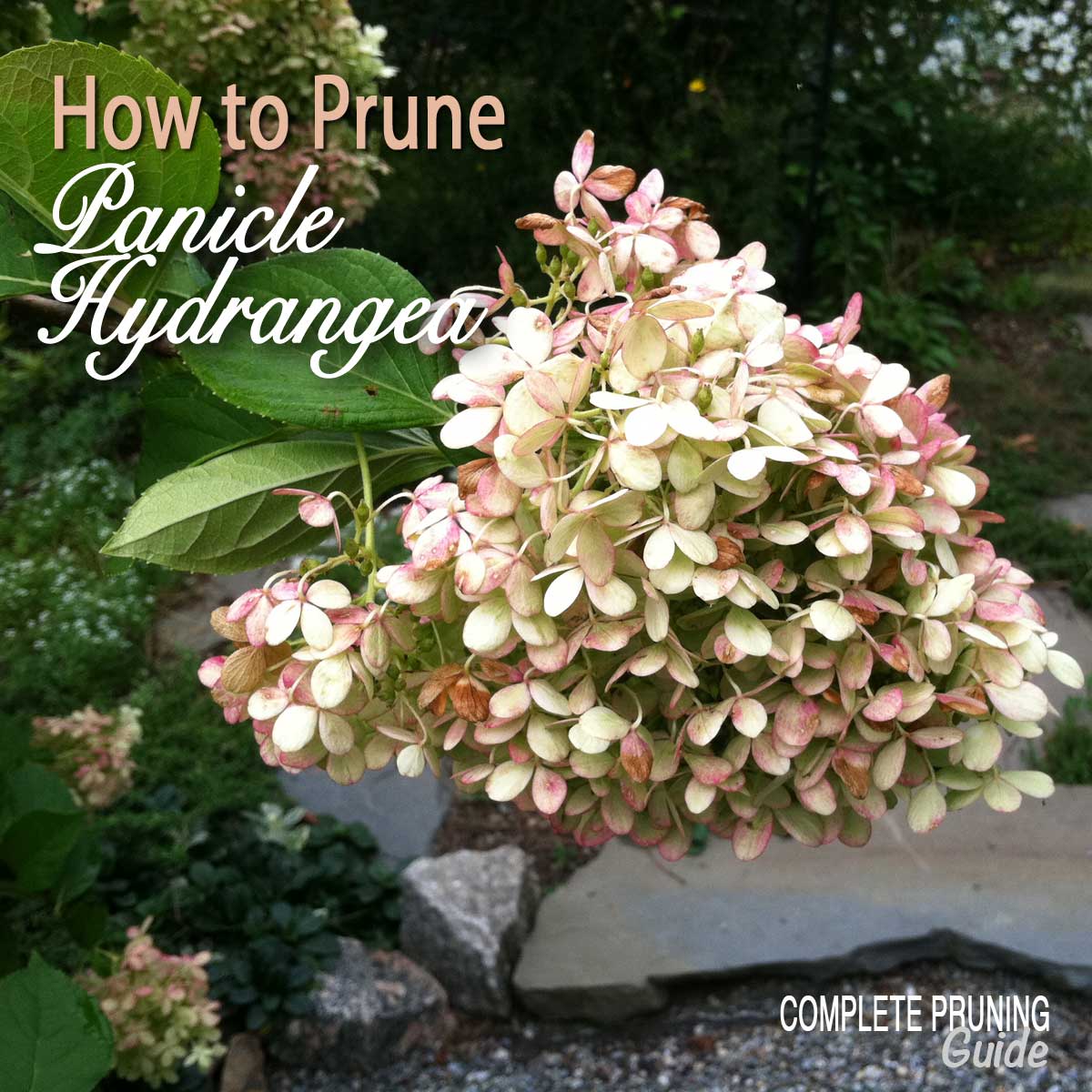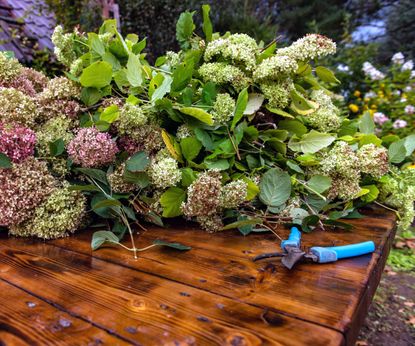When is the Ideal Time to Trim Your Hydrangeas?
Understanding when to prune is crucial for healthy hydrangeas and abundant blooms. The timing depends heavily on the specific type of hydrangea you have. It is important to know if your hydrangea blooms on old wood or new wood. Old wood bloomers, such as oakleaf and bigleaf hydrangeas, develop their flower buds on the previous year’s growth. Pruning these at the wrong time can remove the buds, resulting in fewer to no blooms. Therefore, it is important to know how to prune a hydrangea of this type. The general guideline for these varieties is to prune immediately after they finish flowering, usually in late summer. This allows the plant to set new buds for the following year. Avoid pruning these types in late fall, winter, or early spring, as you risk cutting off the forming buds.
New wood bloomers, including smooth and panicle hydrangeas, produce their flowers on the current season’s growth. These types of hydrangeas are more forgiving when it comes to pruning timing. The best time to prune these varieties is in late winter or early spring, just before new growth begins. This allows you to shape the plant and remove any dead or weak stems. Understanding how to prune a hydrangea that blooms on new wood is key to encouraging vigorous new growth and larger blooms. Incorrect timing is a common reason for a lack of flowers. Pruning old wood bloomers too late in the year will remove next season’s buds. Likewise, unnecessary pruning of new wood bloomers in the wrong time will not cause lack of blooms, but it will not stimulate its growth.
Essential Tools for Hydrangea Pruning
Proper preparation ensures successful pruning. The essential tool for any gardener looking to learn how to prune a hydrangea is a good pair of bypass pruners. These pruners make clean cuts. Clean cuts are crucial for the plant’s health. Sharp blades prevent tearing and crushing of stems. This reduces the risk of disease. Using bypass pruners provides a precise cut. This encourages faster healing and healthy new growth. It is important to always make sure that tools are clean, this prevents disease from spreading to your plant or other plants you might have.
Gloves are another important tool. They protect your hands from thorns and sap. Some hydrangeas have thorns that can cause discomfort. Wearing gloves makes pruning more comfortable. It also protects your hands from dirt. For older, established hydrangeas, thicker stems may require a small pruning saw. A pruning saw allows for a smoother cut on thicker branches. When working with any tool, safety is important. Disinfectant spray is an important, but often overlooked tool. Using a disinfectant spray on your pruners before and after pruning prevents the spread of plant diseases. This is a simple, yet vital step. Knowing how to prune a hydrangea also means knowing how to care for its health. Regular cleaning of tools ensures long-lasting performance and helps keep plants healthy.
Having these tools will help you achieve your pruning goals effectively. Clean, sharp tools also make the job easier. Remember to always have all your tools prepared and ready to use before getting started. This promotes efficient and effective pruning. With the correct tools, you can help ensure that your hydrangeas thrive. They will continue to provide beautiful blooms every year. Using the correct tool for every task is an essential part of learning how to prune a hydrangea. By keeping your equipment well maintained you will be able to enjoy your garden for years.
A Step-by-Step Guide on How to Shape a Bigleaf Hydrangea
Understanding how to prune a hydrangea, specifically the bigleaf variety, requires a delicate approach. These hydrangeas bloom on old wood, meaning they develop their flower buds on the previous year’s growth. Therefore, heavy pruning should be avoided, as this can significantly reduce or eliminate blooms for the following season. The primary focus when pruning a bigleaf hydrangea should be on removing any dead, damaged, or diseased stems. This is crucial for promoting overall plant health and preventing the spread of any potential issues. Use sharp, clean bypass pruners to make precise cuts, ensuring you don’t tear or crush the stems. When identifying dead stems, look for branches that are brittle, dry, and lack any signs of life, such as swelling buds. Remove these first, cutting back to the base of the plant or to a healthy node.
After addressing dead or unhealthy growth, lightly tidy the plant to encourage new shoots from the base. When learning how to prune a hydrangea like the bigleaf type, it’s important to remember that your main goal isn’t to drastically reshape it. Instead, your task is to encourage new growth. The process involves snipping off any spent flowers by cutting just below the flower head, ideally to the first set of leaves. Be careful not to remove any healthy stems with buds, as these will produce the flowers for the next blooming season. Lightly thinning out crowded stems can also be beneficial. This will improve air circulation and light penetration, promoting stronger growth. This method of light pruning helps maintain the natural shape and structure of the bigleaf hydrangea, while also encouraging new growth without sacrificing the following year’s blooms. Remember, patience is key when pruning bigleaf hydrangeas, since over-pruning can be detrimental.
Techniques for Pruning Panicle Hydrangeas for Maximum Growth
Panicle hydrangeas present unique pruning needs because they bloom on new wood. This means they can be pruned more aggressively than other types of hydrangeas. The ideal time to prune panicle hydrangeas is late winter or early spring. This timing allows gardeners to remove old growth before the plant expends energy on it. Knowing how to prune a hydrangea, especially a panicle variety, involves cutting back stems by approximately one-third to one-half. This method encourages vigorous new growth. It also leads to larger and more abundant blooms. Remove any crowded or crossing branches. This practice promotes good air circulation and healthy growth patterns. Proper pruning techniques are essential for the overall health and appearance of the plant.
Understanding how to prune a hydrangea, particularly the panicle variety, ensures that the plant produces the best possible blooms. Begin by assessing the overall structure of the plant. Identify any stems that are damaged or growing in undesirable directions. Cut back these stems to a point just above a healthy bud. For stronger stems, focus on trimming to approximately one-third of their length. This promotes a balanced and robust growth. Remove crossing or rubbing branches to reduce friction damage. It is also essential to remove any branches that are overcrowded. This enhances the air circulation and sunlight penetration throughout the plant. These steps are all vital to maximize the growth and flower production of panicle hydrangeas.
Knowing how to prune a hydrangea such as a panicle type can seem daunting, but it is straightforward with practice. After removing about one-third to one-half of the stem’s length, assess the overall shape of the plant. The goal is to encourage an open framework. This allows for better airflow and light distribution, maximizing the blooming potential. Cutting back to healthy buds allows for new, strong growth. Remember, panicle hydrangeas bloom on new wood, so annual pruning will not hinder blooms. It will in fact enhance them. Consistent pruning each year will help keep the plant healthy. It will ensure that it continues to deliver stunning flowers.
Pruning Smooth Hydrangeas: A Simple Approach
Smooth hydrangeas, known for their large, rounded flower heads, bloom on new wood. This characteristic simplifies the process of how to prune a hydrangea of this type. Unlike their old-wood blooming cousins, smooth hydrangeas offer more flexibility in pruning. A similar approach to pruning panicle hydrangeas works well. This method involves cutting back the stems. Prune them to just above a pair of buds. Alternatively, stems may be cut down to the ground. This more dramatic approach is suitable for vigorous plants. The timing for pruning these hydrangeas is best in late winter or early spring. This is before new growth begins. This timing ensures that the plant’s energy goes towards creating new, strong stems that will support abundant blooms. The primary goal of pruning smooth hydrangeas is to encourage new growth.
When you consider how to prune a hydrangea that is a smooth variety, keep in mind the importance of removing weak or thin growth. This encourages the plant to focus its resources. It will create thicker and stronger stems. This practice is particularly beneficial in the first few years of the plant’s life. Removing weaker stems helps establish a solid framework. It improves the overall health and vigor of the plant. Another key aspect of pruning is to look for stems that are crossing or rubbing together. These stems should be removed to prevent damage. It also promotes better air circulation. Air flow is essential to prevent disease. Regular pruning will help the plant to be its best. The blooms will be large and the plant will be healthy.
The simplicity of pruning smooth hydrangeas makes them a great choice for gardeners of all skill levels. Whether cutting stems to the ground or just above a set of buds, the aim is the same. You want to encourage strong, new growth that will yield a magnificent display of flowers. The flexibility with how to prune a hydrangea of this type is beneficial. It allows gardeners to tailor their approach to the specific needs and aesthetics of their landscape. Remember to use sharp, clean tools to avoid damaging the plant. The correct pruning technique is a simple yet essential part of hydrangea care. It leads to healthier and more beautiful plants.
Addressing Common Hydrangea Pruning Mistakes
A frequent error when learning how to prune a hydrangea is pruning old wood bloomers, like bigleaf and oakleaf hydrangeas, at the wrong time of year. These hydrangeas set their flower buds on the previous year’s growth. Pruning them in the late fall or early spring will remove those buds, resulting in fewer blooms or no blooms at all in the coming season. This outcome is a common disappointment for many gardeners. It’s essential to understand the blooming habits of your hydrangeas to avoid such mistakes. To prevent this, always determine if the plant blooms on old or new wood. This knowledge will guide when to prune, ensuring the preservation of the next season’s flower buds. Avoid any heavy pruning or cutting back on old wood bloomers. It is necessary to focus only on light tidying by removing dead, damaged, or diseased stems. This approach preserves the plant’s flowering potential.
Another common mistake is over-pruning, regardless of the hydrangea type. Heavy pruning, even on new wood bloomers like panicle and smooth hydrangeas, can stress the plant. Over-pruning also removes too much of the plant’s energy reserves, affecting its ability to produce blooms and overall health. It’s best to proceed with care, removing only what is necessary to encourage new growth and maintain shape. For old wood bloomers, the best way to prune a hydrangea is to lightly tidy and to remove dead, damaged, or crossing stems. For new wood bloomers, cut back about one-third to one-half of the stems to encourage vigorous growth. Always remember to use clean, sharp pruners to prevent disease. Pruning should be a deliberate process, ensuring the plant has enough energy and resources to produce beautiful blooms. Patience is key; understanding that pruning is a long-term practice that promotes the plant’s health over several seasons.
Finally, many gardeners try to correct pruning mistakes immediately, which can further harm the plant. Understanding how to prune a hydrangea effectively requires patience and the realization that mistakes are not always reversible. If you have pruned at the wrong time, you cannot put the buds back. The plant will adapt, but it’s important to not overcompensate by aggressively pruning again. Instead, focus on providing the proper care, like balanced fertilization and adequate watering. This will help it recover and prepare for the next growing season. Consistent proper care and adherence to correct timing are the best ways to nurture your hydrangeas. These practices will ensure healthy plants and an abundance of flowers in future years. It is best to learn the proper pruning methods for your specific variety of hydrangea.
The Art of Deadheading and Its Benefits
Deadheading, the practice of removing spent flowers, is beneficial for all types of hydrangeas. It is an important step in how to prune a hydrangea and promote its overall health and appearance. Properly deadheading a hydrangea redirects the plant’s energy. This energy is then used for new growth and bloom production, rather than seed development. To deadhead, cut back the stem to the first set of leaves below the spent bloom. This encourages the plant to focus on creating new buds and foliage. Regularly deadheading makes the plant look more tidy and aesthetically pleasing. Neglecting deadheading may lead to less vibrant blooms and a less appealing overall appearance. Understanding how to prune a hydrangea includes mastering the art of deadheading for optimal results.
Deadheading also helps to maintain the plant’s shape and health. When spent flowers are left on the plant, they can become a breeding ground for pests or diseases. By removing them, you are helping to prevent these issues. This simple act of cutting off the spent flowers is a key step in how to prune a hydrangea effectively and helps promote a healthy growth environment. Deadheading is not only about making the plant look nicer, it is about keeping the plant healthier and encouraging better blooms next year. It is part of overall plant care and a basic practice for anyone looking to get the most out of their hydrangeas. This easy task helps redirect the plant’s resources in the most beneficial way, ensuring continuous growth and better blossoms. Mastering how to prune a hydrangea includes incorporating this simple yet impactful practice into your routine.
Nurturing Your Hydrangeas After Pruning
Post-pruning care is essential for healthy hydrangea growth. Proper care helps prepare hydrangeas for next season’s blooms. After you learn how to prune a hydrangea, fertilizing is a key step. Use a balanced fertilizer to provide the necessary nutrients. Apply it according to package instructions. Mulching around the base of the plant is also beneficial. Mulch helps retain moisture in the soil. It also aids in regulating soil temperature. Water your hydrangeas adequately. Consistent watering is important after pruning. These practices support healthy growth. They also ensure vibrant blooms.
Monitoring your hydrangeas for pests or diseases is important. Early detection allows for prompt treatment. Use appropriate pest control methods. If you notice any issues, seek advice from a gardening professional. Proper watering helps maintain soil moisture. Over or underwatering can stress the plant. Apply fertilizer in spring, following the product directions. It provides necessary nutrients for new growth. How to prune a hydrangea is not the only factor. Post-pruning care plays a vital role in successful blooms. This includes mulching, which helps to suppress weeds.
Taking these steps ensures your hydrangeas thrive. These practices help them produce abundant flowers. Mulch with organic materials for added benefit. Ensure the mulch does not touch the stems. Consistent care after you learn how to prune a hydrangea will increase its health. Hydrangeas will also be more resilient. These post-pruning techniques are crucial for overall plant health. Regular checks for disease will help in preventing bigger issues. Healthy plants are better at fighting off diseases. Taking the time to care for your hydrangeas properly provides beauty for years to come.




